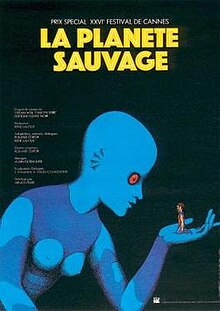Fantastic Planet (La Planète sauvage)(1973) (1973)
Filed under: Animation, 1970s, Czech Republic, Czechoslovakia, France, Jiří Trnka Studio, Réne Laloux, Slovakia, Technicolor,
Fantastic Planet (La Planète sauvage)(1973)

Poster of Fantastic Planet
Directed by: Producers:Simon Damiani
Anatole Dauman
Andre Valio-Cavaglione
Vaclav Strnad
Jindriska Beberová
Jindrich Bárta
Zdena Bártová
Lidia Cardet
Renáta Celbová
Dana Drábová
Nadezda Dvoráková
Helena Horálková
Zuzana Jupová
Viktorie Kolariková
Eva Kretzerová
Josef Kábrt
Helena Najdrovská
Katerina Nováková
Alena Pokorná
Jarmila Rabanová
Helena Rohrauerová
Marcela Schneiderová
Bohumil Sejda
Zdenek Sob
Karel Strebl
Marie Tomasková
Eva Udrzalová
Jirí Vokoun
Josef Vána
Alena Wellnerová
Alain Goraguer
Studio:Jiří Trnka Studio
Release date:11/05/1973 (Cannes); 06/12/1973 (France); 21/12/1973 (Czechslovakia)
Running time:1 min 35 s (clip); 71 min (full length)
Color process:Technicolour
Synopsis
Fantastic Planet (1973), based on Stefan Wul’s novel Oms en série (1957), takes place in a distant future where the giant blue-skin aliens, the Draags, enslave and oppress humans. Terr, the protagonist, is a human boy raised as a pet of a Draag girl, Tiwa, who, despite relatively kind treatment, gives him a collar to restrict his movement. The defect in Terr’s collar allows him to receive knowledge from the headset that Tiwa uses for learning, contributing to his ultimate escape into the wilderness, where he meets a tribe of free humans. The headset that he brings with him during escape allows the tribe to acquire knowledge and literacy just like the Draags, enabling them to confront the Draags’ periodical slaughter while allying with other human tribes and replicating the Draags’ technology to create two rockets that become the key to the humans’ liberation. Upon launching the rockets towards the moon, also known as the Fantastic Planet, the humans discover that the Draags journey to this planet during meditation to participate in mating rituals vital to the continuation of their species. Humans now pose a threat to the Draags’ existence, forcing a halt to the genocide against them. The war between two species concludes with an artificial satellite planet given to humans as their new home.
Reception:
Jiří Trnka Studio’s attention to the Czech tradition of minimalist technique, exemplified through the use of silhouettes of cutouts as a mythical approach and stop-motion effects that force the audience to seek information from all sorts of details filling the frame, results in Fantastic Planet’s bizarre, psychedelic, and surrealist aesthetic (Brode 174).
Fantastic Planet debuted during 1973’s Cannes Film Festival, where it received the Special Award and a nomination for the Palme d’Or. Afterwards, in 1975, the Nebula Award nominated director Réne Laloux and screenwriter Roland Topor for the Best Dramatic Presentation. (“Fantastic Planet (1973) – Awards – IMDb”).
References:
Brode, Douglas. “Fantastic Planet/La Planète Sauvage (1973).” Fantastic Planets, Forbidden Zones, and Lost Continents, University of Texas Press, 2015.
“Fantastic Planet (1973) – Awards – IMDb.” IMDb, www.imdb.com/title/tt0070544/awards/?ref_=tt_awd. Accessed 30 July 2024.
